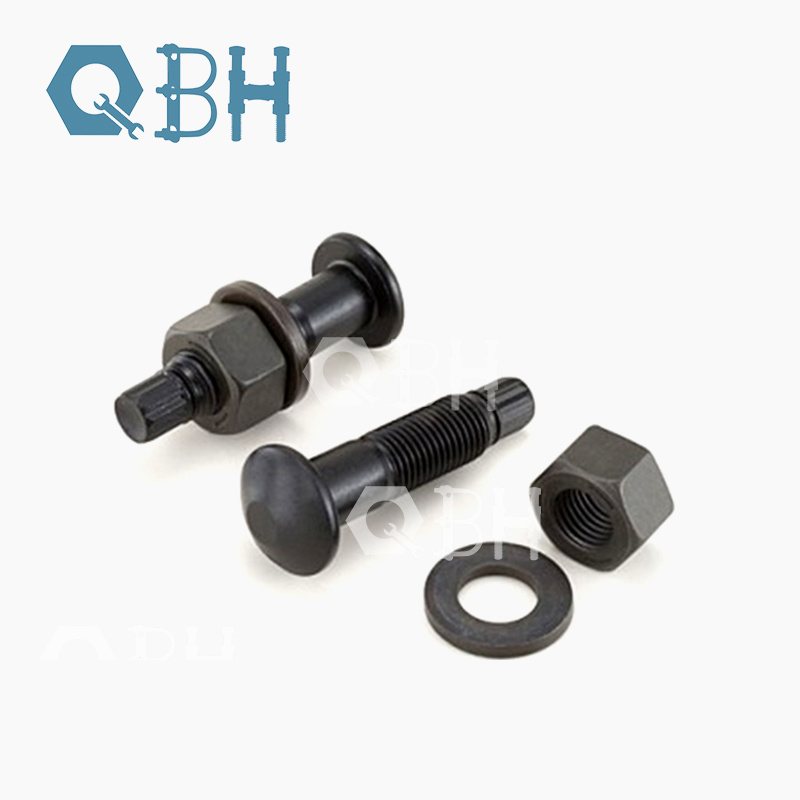Why Use Torsional Shear Bolts for Structural Fastening?
2025-10-14
In the field of structural engineering and heavy construction, the Torsional Shear Bolt (TSB) represents one of the most advanced and efficient fastening technologies available today. Designed to deliver consistent tension and shear performance, Torsional Shear Bolts have become an essential component in high-strength connections, especially in steel frameworks, bridges, high-rise buildings, wind turbines, and heavy machinery.
Unlike conventional bolts, which depend heavily on torque control and manual tightening accuracy, the Torsional Shear Bolt employs a mechanical design that guarantees a pre-set tension through the controlled breaking of its tip. Once the bolt reaches the required torque and tension threshold, the spline end automatically snaps off — ensuring a perfectly tensioned bolt every time. This eliminates guesswork, human error, and the need for expensive torque measurement tools.
Why Are Torsional Shear Bolts Gaining Popularity Across Industries?
Precision and Consistency
One of the key reasons behind the growing adoption of Torsional Shear Bolts lies in their self-regulating tightening mechanism. Traditional high-strength bolts require torque verification to ensure the correct preload. However, Torsional Shear Bolts use a calibrated spline that shears off at the precise torque, ensuring every bolt achieves the same level of tension. This precision results in uniform load distribution and improved structural integrity, minimizing the risk of bolt relaxation or joint slippage.
Faster Installation
The simplified design of Torsional Shear Bolts enables quicker installation, reducing labor time by up to 40% compared to conventional friction-grip bolts. Workers only need a shear wrench, which simultaneously grips the nut and spline, applying torque until the spline shears off automatically. This process eliminates the need for torque calibration, double-checking, or re-torquing after a few hours.
Safety and Reliability
Torsional Shear Bolts provide predictable, reliable tensioning under all conditions. The built-in shearing mechanism ensures every bolt performs to exact specifications. The result is a safer assembly that complies with international structural standards, such as ISO 898, ASTM A325, and EN 14399.
Cost Efficiency
Although Torsional Shear Bolts may initially seem more expensive than conventional fasteners, the total project cost is reduced through faster installation, minimal maintenance, and reduced inspection requirements. Contractors and engineers benefit from both time savings and long-term reliability.
What Makes Torsional Shear Bolts Technically Superior?
To highlight the engineering excellence behind these bolts, the following specifications demonstrate the precision and performance of typical Torsional Shear Bolts used in steel structures:
| Parameter | Specification |
|---|---|
| Product Name | Torsional Shear Bolt |
| Material | High-Tensile Carbon Steel (Grade 10.9 or 8.8) |
| Finish Options | Hot-Dip Galvanized, Zinc Plated, Dacromet, Black Oxide |
| Diameter Range | M16 – M36 |
| Thread Type | Metric ISO Fine Thread |
| Tensile Strength | 1040 – 1220 MPa |
| Yield Ratio | ≥ 0.9 |
| Shear Strength | 0.58 × Tensile Strength |
| Breaking Torque Tolerance | ±10% |
| Applicable Standards | ISO 898-1, BS EN 14399-10, ASTM F1852 |
| Applications | Steel bridges, high-rise structures, transmission towers, wind turbines, mechanical joints |
| Packaging | Sets including bolt, nut, and washer |
How It Works
The bolt has a splined end designed to break at a specific torque level. When tightened with a calibrated shear wrench, the spline twists off once the desired tension is achieved. This mechanism ensures that every bolt installed in a project maintains uniform preload without the need for post-tightening inspections.
Structural Benefits
-
Uniform Tensioning: Reduces uneven load distribution in joints.
-
Vibration Resistance: Performs exceptionally well in dynamic or seismic conditions.
-
Corrosion Protection: Various coatings enhance durability in harsh weather environments.
-
Maintenance-Free Design: No need for periodic retightening.
-
Time-Saving Installation: Ideal for mass construction where speed and accuracy are critical.
Engineering Adaptability
Torsional Shear Bolts can be customized according to project requirements — from bolt head geometry, coatings, and grades to specialized nuts and washers designed for anti-corrosion and high-load environments.
How Are Torsional Shear Bolts Shaping the Future of Fastening Systems?
The demand for smarter and more efficient fastening systems is transforming construction technology. Torsional Shear Bolts are leading this transition due to their ability to combine mechanical simplicity with engineering accuracy. The global construction industry is embracing these bolts as the standard for high-strength structural connections.
Technological Advancements
Recent developments in material science and surface treatment have enhanced the fatigue resistance, corrosion performance, and torque accuracy of Torsional Shear Bolts. New coating technologies, such as Dacromet and Geomet, offer longer service life and eco-friendly protection against rust and chemical exposure.
Environmental and Efficiency Benefits
As sustainability becomes a key consideration, Torsional Shear Bolts contribute to greener construction practices. Their quick installation reduces machinery usage and energy consumption on-site, while long-term durability reduces replacement needs, lowering the overall environmental footprint.
Integration with Smart Construction
In modern digital construction (BIM-integrated projects), Torsional Shear Bolts are preferred because of their predictable torque-tension correlation. Their installation can be tracked and validated digitally, ensuring traceable quality assurance for every connection point in large infrastructure projects.
Future Outlook
Industry trends suggest that Torsional Shear Bolts will continue to replace conventional bolts in bridge construction, prefabricated modular buildings, offshore structures, and renewable energy projects. The combination of reliability, efficiency, and sustainability positions them as the fastener of choice for the next generation of global construction.
Common Questions About Torsional Shear Bolts
Q1: How do Torsional Shear Bolts differ from friction grip bolts?
A: Friction grip bolts rely on torque control and the friction between clamped plates to hold joints together. Torsional Shear Bolts, however, employ a mechanically calibrated shear point that guarantees a specific pre-tension, regardless of operator skill or torque verification. This makes them more consistent, faster to install, and easier to inspect visually since the sheared spline confirms proper installation.
Q2: Can Torsional Shear Bolts be reused after removal?
A: No. Once a Torsional Shear Bolt’s spline end breaks off, it indicates that the bolt has achieved its full design preload. Reusing such bolts can compromise the structural integrity of the connection because the tensioning mechanism cannot be recalibrated. For safety and compliance reasons, a new bolt set should always be used for replacement or reassembly.
Why Choose QBH for Torsional Shear Bolts?
As global infrastructure demands precision and durability, QBH stands at the forefront of high-performance fastening solutions. With years of expertise in bolt manufacturing and surface treatment, QBH produces Torsional Shear Bolts that meet international standards and project-specific requirements. Each bolt undergoes strict quality inspection, dimensional testing, and mechanical evaluation to guarantee consistent performance in the most demanding environments.
QBH’s product range includes not only Torsional Shear Bolts, nuts, and washers, but also custom-engineered fasteners designed for special structural applications. By integrating advanced production technology, eco-friendly coatings, and rigorous inspection systems, QBH ensures reliability, safety, and global compatibility.
For engineers, builders, and project managers looking to improve connection efficiency and reduce installation time, QBH offers comprehensive technical support and tailored fastening solutions.
Contact us today to learn more about QBH’s Torsional Shear Bolts, request detailed specifications, or discuss your project requirements with our engineering team. QBH is committed to delivering the quality, precision, and performance that modern construction demands — ensuring every connection you build is strong, safe, and enduring.





